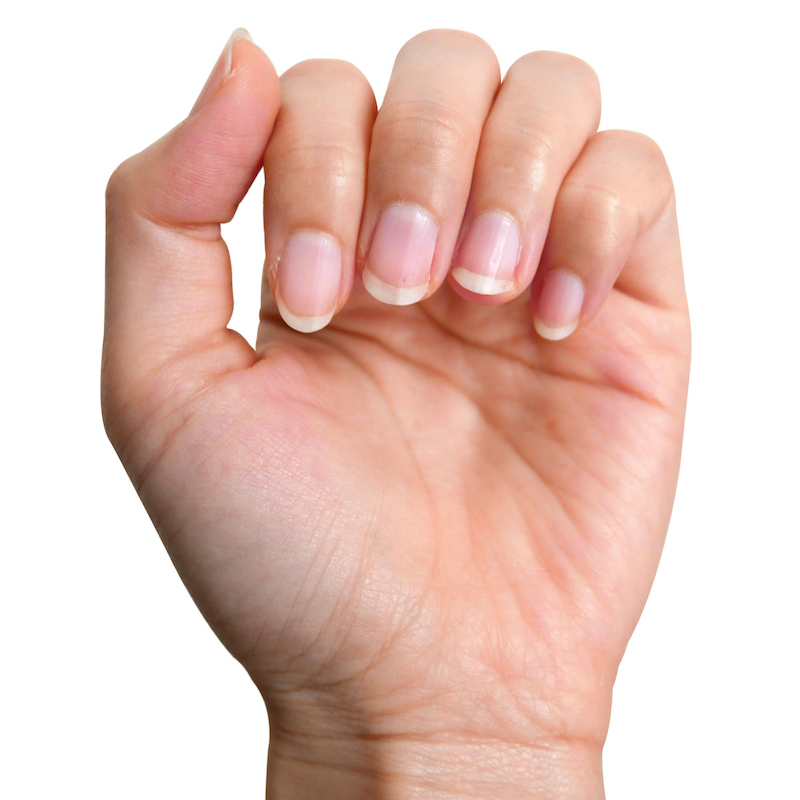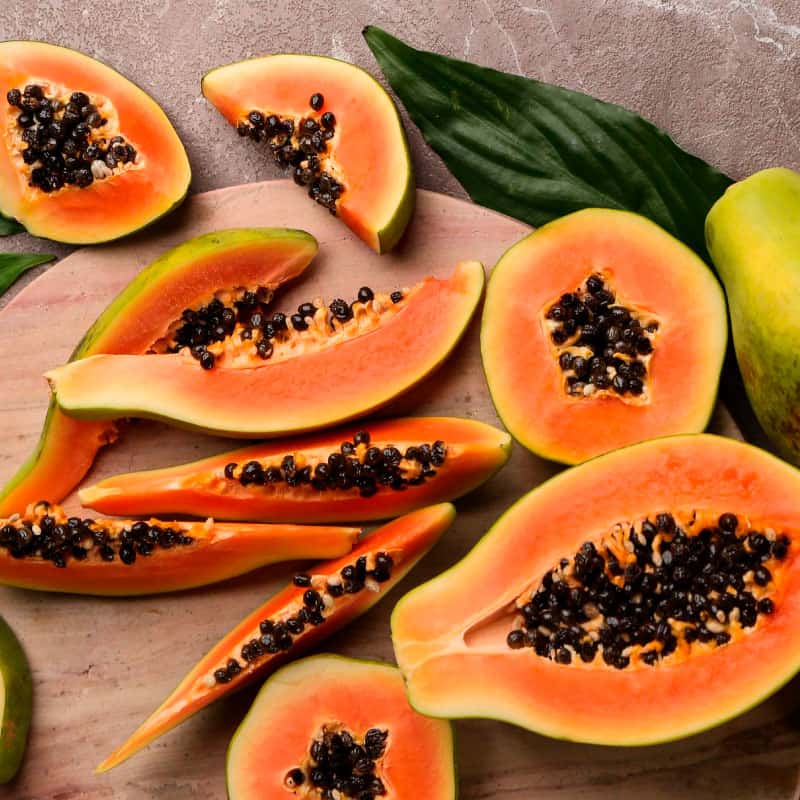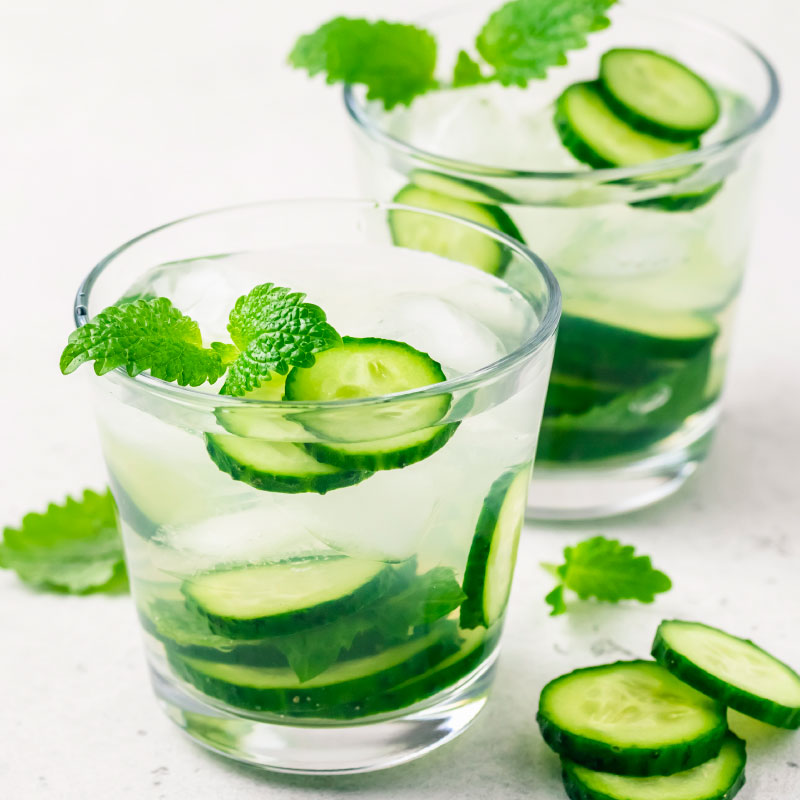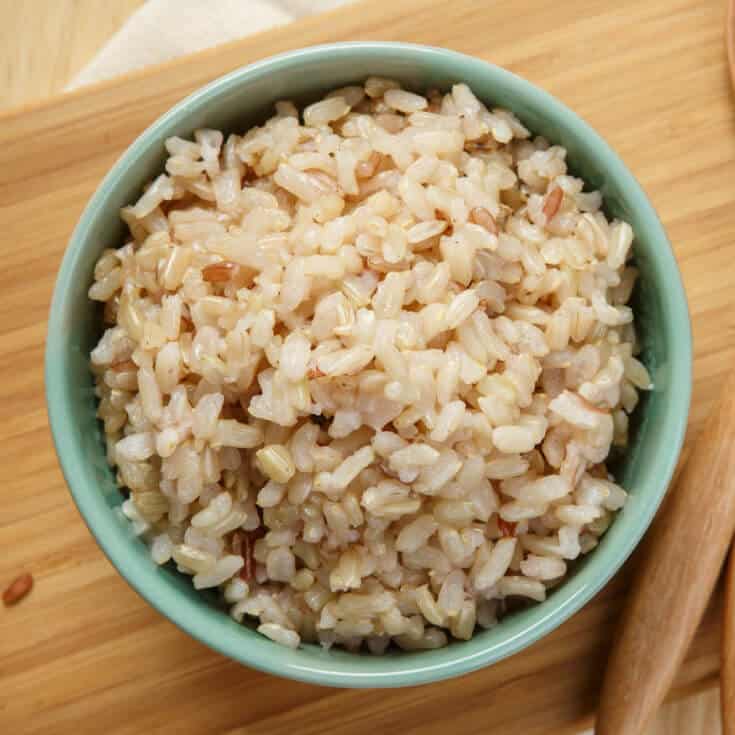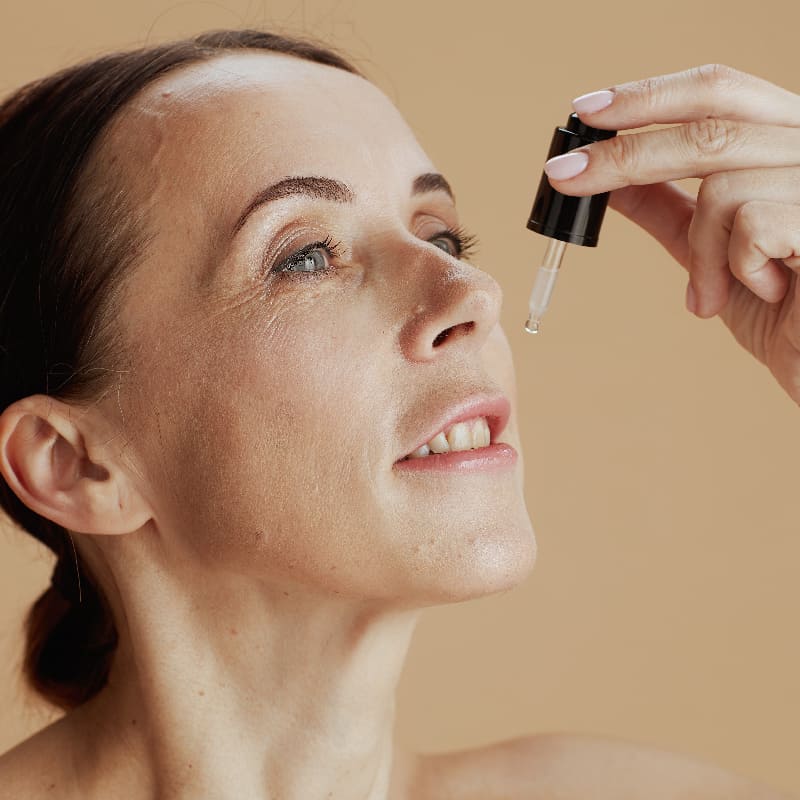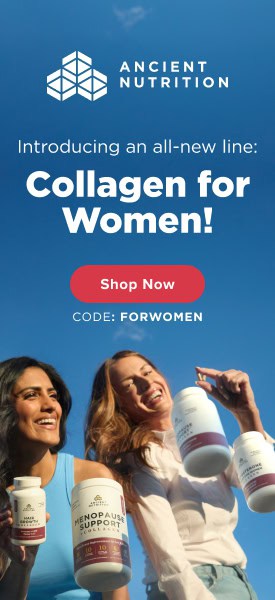This Dr. Axe content is medically reviewed or fact checked to ensure factually accurate information.
With strict editorial sourcing guidelines, we only link to academic research institutions, reputable media sites and, when research is available, medically peer-reviewed studies. Note that the numbers in parentheses (1, 2, etc.) are clickable links to these studies.
The information in our articles is NOT intended to replace a one-on-one relationship with a qualified health care professional and is not intended as medical advice.
This article is based on scientific evidence, written by experts and fact checked by our trained editorial staff. Note that the numbers in parentheses (1, 2, etc.) are clickable links to medically peer-reviewed studies.
Our team includes licensed nutritionists and dietitians, certified health education specialists, as well as certified strength and conditioning specialists, personal trainers and corrective exercise specialists. Our team aims to be not only thorough with its research, but also objective and unbiased.
The information in our articles is NOT intended to replace a one-on-one relationship with a qualified health care professional and is not intended as medical advice.
Natural Treatments for Rotator Cuff Pain + Best Rotator Cuff Exercises
July 11, 2025
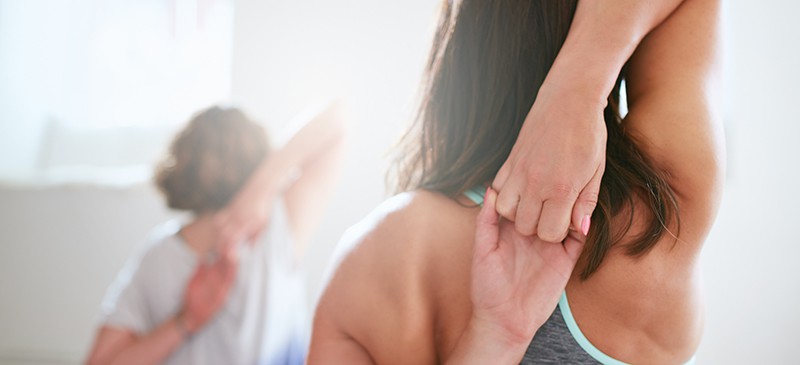
Most of us likely are unaware of just how important the shoulders are. Well, that is until you injure one of them. A shoulder that is in pain of any sort, including rotator cuff pain, can cause daily activities such as brushing your teeth, taking a shower, getting dressed, combing your hair and even sleeping difficult and frustrating. Luckily, there are rotator cuff exercises and stretches, along with other natural remedies, that can help.
If fitness is important to you, having a rotator cuff tear, like suffering from frozen shoulder syndrome, can make even the smallest amount of exercise more challenging and possibly painful. That’s why it’s vital to target the source of your rotator cuff pain and slowly ease in to rotator cuff exercises that can help regain range of motion, strength and functionality.
What is the rotator cuff?
The human shoulder is made up of a somewhat complicated system of bones, joints, connective tissues and muscles that provide the support needed for the arm to function properly. It’s believed that the upper extremities can acquire more than 1,600 positions within a three-dimensional space at the shoulder joint.
As long as the shoulder is working properly, complicated activities like throwing a ball, shoveling snow, raking the leaves, climbing, lifting weights and swimming are possible. Well-functioning shoulders are vital to physical activity!
In fact, chronic shoulder pain, which lasts more than a few weeks to a few months, is the most commonly reported upper-extremity problem in athletes, both recreational and professional.
The rotator cuff is a group of tendons and muscles that are located in the shoulder and upper back area, connecting the upper arm to the shoulder blade. The tendons of the rotator cuff provide stability to the shoulder area, and the muscles allow the shoulder to rotate.
Your shoulder is made up of three bones: your upper arm bone that is called the humerus, your shoulder blade known as the scapula and your collarbone that is named the clavicle. The shoulder is a ball-and-socket type joint where the ball, or head, of your upper arm bone fits perfectly into a shallow socket in your shoulder blade area.
The rotator cuff tendons and rotator cuff muscles play pretty important roles since they are what keeps the arm in the shoulder socket. There is a network of four muscles that comes together as tendons to form a covering around the head of the humerus, and that is what we call the rotator cuff.
The rotation and ability to lift the arm comes from the rotator cuff, so as you can imagine, when it is causing pain, it can be rather debilitating and very frustrating.
The muscles in the rotator cuff include the teres minor, infraspinatus, supraspinatus and subscapularis. There is also what is known as a lubricating sac, or bursa, which is located between the rotator cuff and the bone on top of your shoulder called the acromion.
The bursa is what allows the rotator cuff tendons to freely move and glide as you engage your arm in any motion or activity. When the rotator cuff tendons are injured or damaged, this bursa can also become inflamed and painful.
Common rotator cuff injuries
There are many common causes of rotator cuff pain and/or injury, which is typically a torn rotator cuff, such as falling or being hit in the shoulder (i.e., playing football or rugby), or unexpectedly falling during an activity. Overuse from repeated actions, such as lifting, painting, cleaning windows, swimming, swinging a tennis rack or golf club, or throwing a baseball, are common causes as well.
Unfortunately, issues can also show up from natural wear and tear that comes from aging.
A rotator cuff tear is one of the most common injuries suffered from the shoulder area and is specifically an injury or tear to the rotator cuff tendon. Symptoms may include weakness and/or pain in the arm, and it’s a common cause of pain and disability among adults.
Besides a rotator cuff tear, rotator cuff pain can also come from these problems:
- Rotator cuff tendonitis is the repetitive overhead use of the arms during activities such as gardening, raking, carpentry, house cleaning, shoveling, tennis, golf and throwing.
- Rotator cuff impingement is when the tendons of the rotator cuff are squeezed between the humerus and a nearby bone called the acromion.
- Frozen shoulder occurs when the humerus adheres to the shoulder blade, causing shoulder pain and stiffness.
- Subacromial bursitis happens when there is inflammation of the small sac of fluid, called the bursa, that cushions the rotator cuff tendons from a nearby bone called the acromion.
An injury to the rotator cuff area can make it very painful and annoying to lift your arm out to the side. Tears that happen suddenly usually cause intense rotator cuff pain right away, indicating that there is a problem. There may even be a snapping sensation and immediate weakness in your upper arm area.
When one or more of the rotator cuff tendons is torn, the tendon no longer fully attaches to the head of the humerus. Most tears typically occur in the supraspinatus muscle and tendon, but other parts of the rotator cuff may be involved in an injury.
Tears that develop slowly over time due to overuse also cause rotator cuff pain and arm weakness. You may feel pain in the shoulder area when you lift your arm to the side, or you may feel pain that moves down the arm. The pain may be mild and only noticeable when performing common activities that require you to lift your arm over your head.
Eventually, the pain may become more noticeable, even when the arm is at rest.
Some of the most common symptoms of a rotator cuff tear include:
- Rotator cuff pain at rest and at night, particularly if lying on the affected shoulder
- Pain when lifting and lowering your arm or with specific activities
- Weakness when lifting or rotating your arm in different directions
- Crepitus, which is a grating sound or sensation produced by friction between the bone and cartilage or a crackling sensation when moving your shoulder in certain positions
There are a few different ways to assess issues that may be occurring with the rotator cuff, such as magnetic resonance imaging (commonly known as a MRI), a CT scan, traditional X-rays, a physical exam, ultrasound, arthrogram or a simple painful arc test.
There are many treatments available, such as anti-inflammatory pain medications, sports and fitness tape, cortisone injections, and surgery. But while an injection of a local anesthetic and cortisone may be helpful and provide some profound immediate relief, it’s temporary and probably masks the problem more than anything.
Cortisone is an effective anti-inflammatory medicine, but it comes with possible side effects, such as:
- skin discoloring where shot was administered
- infection
- bleeding from broken blood vessels that may occur within the skin or muscle
- soreness
- aggravation of the inflammation in the injured area because of reactions to the medication (post-injection flare)
- weakened or even ruptured tendons
Natural treatments for rotator cuff pain
A 2010 study of serious injury of the rotator cuff in young athletes through contact sports showed that through the proper treatment, most can get back to a normal routine, including playing sports. However, early identification and efficient management are critical to achieve the best results, according to the researchers.
“These injuries may initially be dismissed as brachial plexus neuropraxias or cuff contusions, particularly in the football population. If overlooked, the rotator cuff tear is likely to progress and may become irreparable by the time of diagnosis.”
While some injuries may require surgery or other conventional medical interventions, there are also natural ways to help relieve rotator cuff pain, and there are even rotator cuff exercises that can help strengthen the joint and protect against potential injury.
Here are some natural treatments for rotator cuff pain to try out:
1. Ice
If you know that you’ve injured yourself, make sure you apply an ice pack to the area immediately afterward. This will reduce inflammation and swelling (and hopefully your rotator cuff pain).
If the ice pack or bag is extremely cold, cover the shoulder with a thin towel or clean cotton T-shirt. Apply for 15 minutes every other hour for the first few hours and then three times a day until you’re free of pain. This includes after any physical therapy or exercising.
2. Rest and spend less time doing normal activities
Often, the initial step to any injury, or even potential injury, is rest. Rest could include more sleep as well as limiting overhead activities.
Your doctor may also prescribe a sling to help protect the shoulder area by keeping it still. This can also help you avoid trying to use it during this rest period.
Overall, for healing to occur, the inflammation needs to be reduced. One of the ways to do that is to avoid activities that cause shoulder and rotator cuff pain.
If you have rotator cuff pain or an injury and continue using the shoulder, even if there isn’t increasing pain, you can cause even more damage. For example, a rotator cuff tear can get bigger and more inflamed over time.
3. Acupuncture
A 2012 study done by the Memorial Sloan-Kettering Department of Epidemiology and Biostatistics aimed to determine the effect of acupuncture for four chronic pain conditions: back and neck pain, arthritis, chronic headache, and shoulder pain.
The researchers reviewed clinical trials involving more than 17,000 patients, and the results showed that patients receiving acupuncture had less pain than patients in the placebo control group. The conclusion was that acupuncture is effective for the treatment of chronic pain and is “more than just a placebo effect, therefore it’s a reasonable referral option for doctors.”
Another randomized, single-blind clinical trial enrolled 52 athletes with rotator cuff tendinitis to compare true acupuncture against a novel placebo-needle control. Over a four-week period, participants received weekly treatments.
Outcome was assessed using the modified Constant–Murley score, which gauges shoulder pain and function. The acupuncture group showed a significantly greater improvement compared to the placebo group.
The researchers concluded that skin penetration by needles (the “needling” component of acupuncture) is a key driver of pain relief, beyond the therapeutic setting alone.
4. Heating pad
Since heat can improve healing, a physical therapist may use a moist heating pad for 15 to 20 minutes before exercise, and it can be useful to do this at home, too. Applying localized heat helps improve circulation and muscle relaxation, reduces pain and stiffness, and supports physical therapy, forming a key component of early-stage rotator cuff pain management.
5. Physical therapy
Overall, physical therapy and occupational therapy may be the best treatments long term and could get you back to a normal routine and restoration much faster than steroid injections and/or surgery alone. Evidence through clinical trials has shown that physical therapy with prescribed rotator cuff exercises can help improve conditions like shoulder impingement, rotator cuff tendinopathy, rotator cuff tears, glenohumeral instability, adhesive capsulitis and stiff shoulders when applied to rehabilitating patients.
Physical therapy involves various rotator cuff exercises and other exercises that can improve flexibility and strength of the other muscles in the rotator cuff, ultimately providing support to help it heal.
Occupational therapy is somewhat similar to physical therapy in terms of the end results, but occupational therapy for rotator cuff pain and injuries focuses on day-to-day activities that require basic shoulder movements. Over time, this strengthens and supports the rotator cuff area and can provide natural healing.

6. Anti-inflammatory foods and natural painkillers
When trying to heal from any injury, it’s important to avoid inflammatory foods and focus on bringing inflammation down. That’s where anti-inflammatory foods, such as leafy greens, berries, fish and seeds, come in.
Anti-inflammatory foods can help you recover much faster while providing other useful benefits to your health. For instance, a controlled clinical observation in Canada evaluated the effects of a whole-food, anti-inflammatory dietary approach on patients with rotator cuff tendinitis.
It found that consuming a diet rich in fruits, vegetables, whole grains and healthy fats, while avoiding processed foods and sugars, led to significant reductions in shoulder pain and inflammation markers. The study concluded that dietary modifications emphasizing natural anti-inflammatory foods may be an effective adjunct therapy for reducing pain and promoting healing in rotator cuff tendinitis.
There are some great natural painkillers for shoulder pain and tendonitis in the rotator cuff that can be very useful as well, including spicy foods, certain oils, Epsom salt, self-myofascial release, bone broth, rolfing and more.
7. Essential oils
Peppermint essential oil is one of those natural painkillers mentioned above. Peppermint oil is a very effective natural painkiller that helps relax the muscles. Simply blend it with coconut or almond oil, and rub onto the affected area.
Other effective anti-inflammatory oils include arnica, evening primrose and lavender oils.
8. Strengthening
Specific rotator cuff exercises can help restore movement and strengthen your shoulder and the muscles and tendons that support it. The goal is to strengthen the muscles that support your shoulder so you get much-needed pain relief while preventing additional injury to the area.
(Learn some of the best rotator cuff exercises below.)
9. Stretching
The other side of the rehab coin to strength moves is stretching. This can help improve flexibility and range of motion, but keep in mind that it takes time and commitment to perform these exercises one or two times per day, three to four days per week.
Also, while you are likely to feel discomfort, if you feel any pain when performing these rotator cuff exercises, please stop immediately and consult your doctor.
Other alternative ways to help treat rotator cuff pain include:
- Ultrasound. To speed blood flow to the damaged tissue, reduce inflammation and increase healing, an ultrasound can heat up deep tissue and address rotator cuff pain.
- Transcutaneous electrical nerve stimulation. This is the use of an electric current that’s produced by a device in order to stimulate the nerves for therapeutic purposes, such as to address rotator cuff pain. One meta-analysis published in the medical journal Current Rheumatology Reports revealed the positive treatment effects of electrical stimulation for relief of chronic musculoskeletal pain, and randomized, controlled trials consistently showed the effectiveness of it for acute, emergent and postoperative pain conditions.
Rotator cuff exercises
A proper conditioning program of physical therapy requires some dedicated time, but you should see some great results. Also, if you have concerns, ongoing pain or sudden pain, please see your doctor or a physical therapist.
As far as rotator cuff exercises you can perform at home, the workout below can be a good guide. Try to do this program for four to six weeks, unless otherwise specified by your doctor or physical therapist.
Once you are recovered, you may want to continue with these rotator cuff exercises as part of a great maintenance program. Performing these rotator cuff exercises two to four days a week can help maintain strength and range of motion in your shoulders.
It’s best to warm up the muscles before doing these rotator cuff exercises (and any other exercises). Choose a low-impact activity for 10 minutes, such as walking, riding a stationary bike, using an elliptical or even performing arm circles, forward and backward, while marching.
Remember: You should not feel pain during an exercise. Talk to your doctor or physical therapist if you have any pain while exercising.
If you are not sure how to do an exercise, or how often to do it, contact your doctor or physical therapist.

Without further ado, here are some of the best rotator cuff exercises to help relieve rotator cuff pain:
1. Crossover arm stretch
Stand with your feet hip-distance apart. Relax your shoulders, and gently pull one arm across your chest as far as possible, holding at your upper arm area, not the elbow. (Avoid putting pressure on the elbow area.)
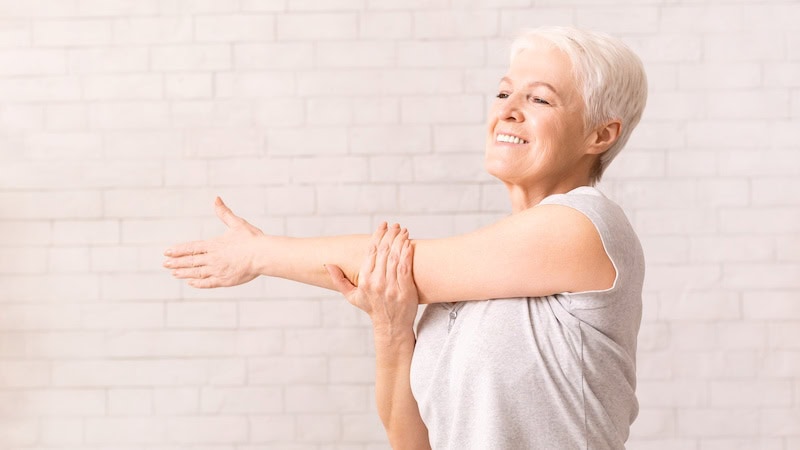
Hold the stretch for 30 seconds, and then relax for 10-15 seconds. Repeat five times on each side.
2. Back rotation
Hold a stick or small hand towel rolled lengthwise behind your back, grabbing one end with one hand, and lightly grasp the other end with your other hand. Pull the stick or towel so your shoulder is stretched to the point of feeling it without pain.
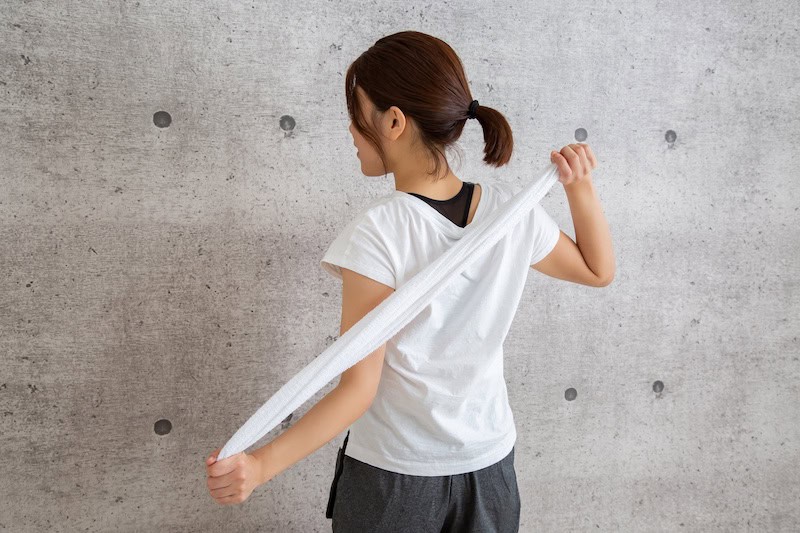
Hold for 20-30 seconds, and then relax for 10-15 seconds. Repeat four times on each side. Maintain good posture, standing with feet hip-distance apart and knees slightly bent, and keep your core tight.
3. Pendulum
Lean forward with your knees slightly bent, and place one hand on a counter or table top for support. Allow the other arm to hang freely at your side.
Gently swing your arm forward and back three to four times, and then repeat the exercise moving your arm side-to-side three to four times. Next, move the arm in a circular motion three to four times.
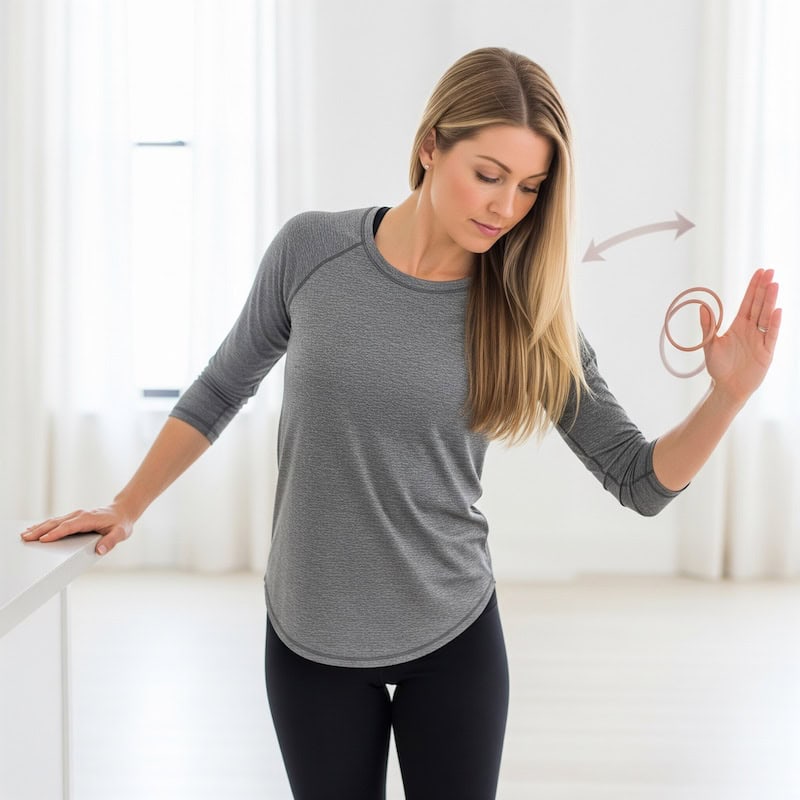
Repeat the entire sequence with the other arm. Be careful not to round your back or lock your knees.
Do two sets of 10 on each side.
4. Standing row
Using an elastic stretch band or a resistance band of comfortable tension, make a loop with the elastic band and put it around a doorknob or sturdy post. You can tie the ends together or, if using the common resistance bands, grab the handles with one hand.
Stand in the start position holding the band with your elbow bent and at your side. Keeping your arm close to your side, slowly pull your elbow straight back. Then slowly return to the start position, and repeat.
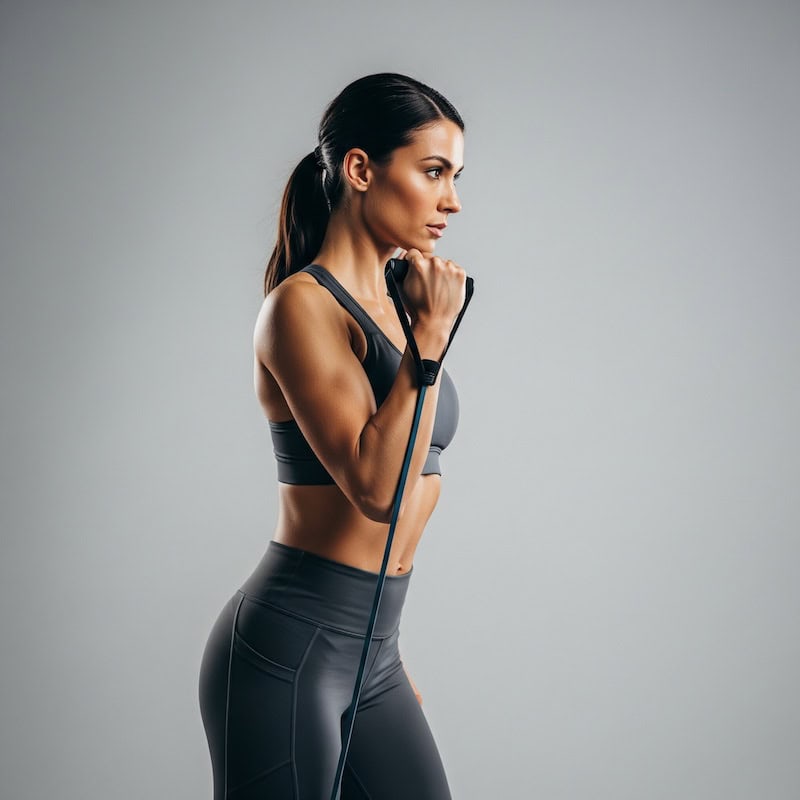
Do three sets of 10, squeezing your shoulder blades together as you pull.
5. Upward rotation
Similar to the exercise above, make a three-foot-long loop with the elastic band, and attach the loop to a doorknob or other stable location. Stand holding the band with your elbow bent at 90 degrees with your knuckles/fist facing forward at shoulder height.
Maintain the positioning with your upper arm and shoulder, making sure your elbow stays in line with your shoulder. Then slowly raise your hand until the forearm is vertical. Return to the start position, and repeat.
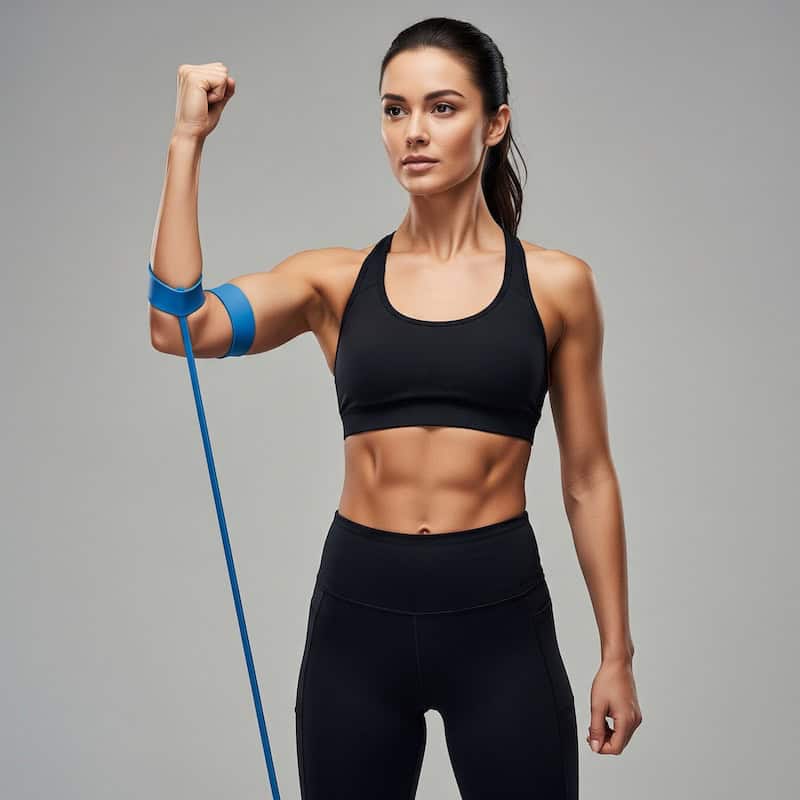
Perform three sets of 10.
6. Inward rotation
Using the same band, stand holding the band with your elbow bent and at your side, fist vertical and facing forward. While keeping your elbow close to your side, bring your arm across your body. Then return to starting position, and repeat.
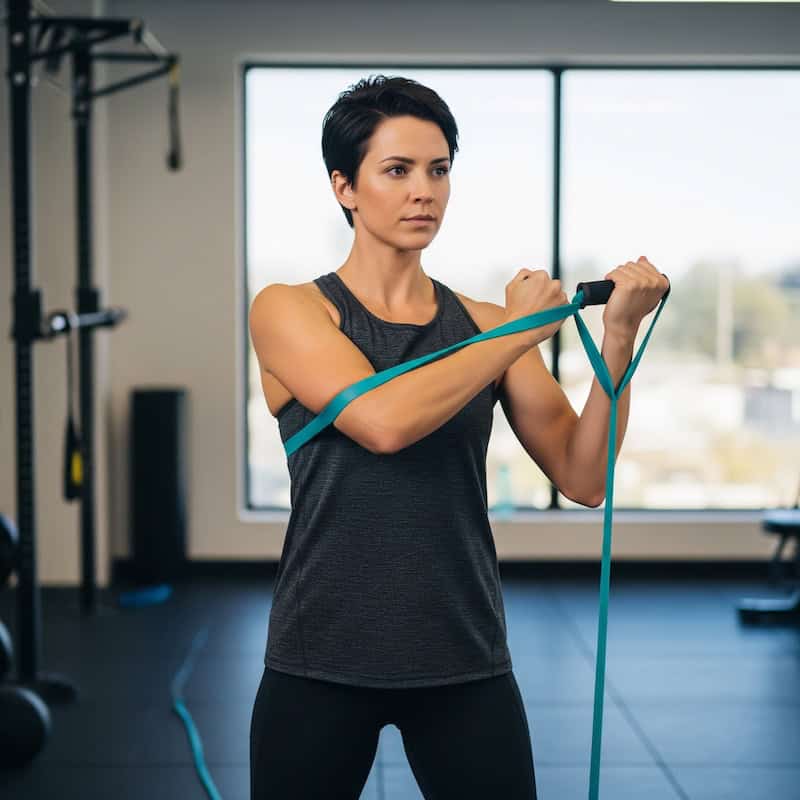
Perform three sets of 10.
7. Outward rotation
This time, instead of rotating inward, simply rotate the arm away from the body. Stand with your feet hip-distance apart, knees slightly bent and abs tight.
Using the same band, arm down at your side, bend the arm at the elbow. Keeping your elbow close to your side, slowly rotate your forearm outward and away from the body, and then return to the starting position. Squeeze your shoulder blades together as you rotate away from the body.
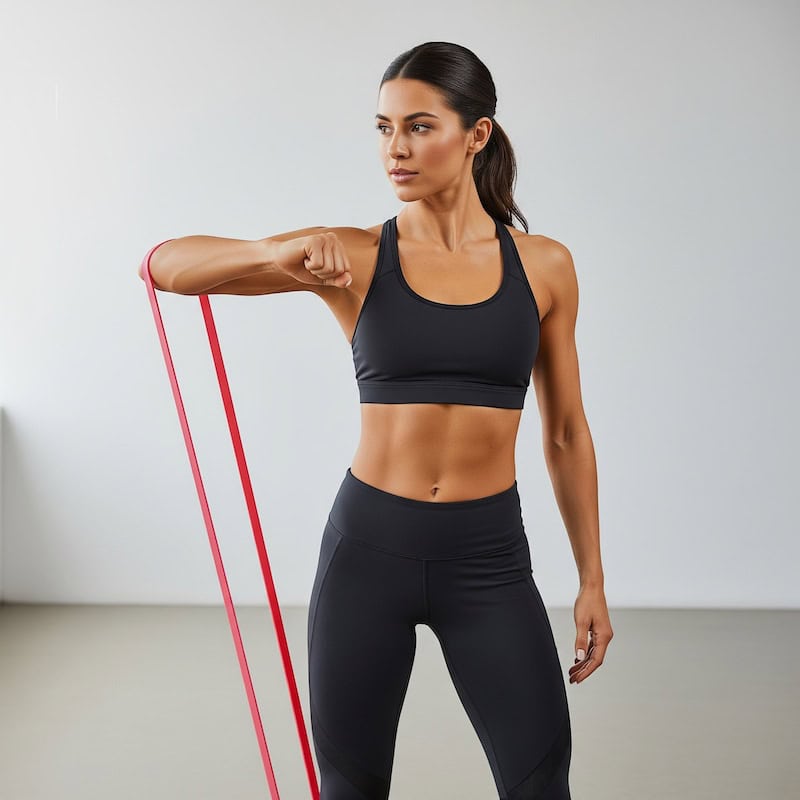
Perform three sets of 10.
Precautions
It’s important to note that since most rotator cuff tears are caused by normal use that comes with aging, most people over 40 are at greater risk. People who do repetitive lifting or activities that require lifting or reaching overhead, such as painters and carpenters, are also at risk for rotator cuff tears and injuries.
Of course, athletes, especially in contact sports and any sport that requires repetitive use, such as tennis, baseball and swimming, are very vulnerable to overuse tears and should exercise caution and be aware of any onset of pain.
While those under 40 can experience issues with the rotator cuff, most of their shoulder injuries are caused by a traumatic injury, like a fall.
Conclusion
- Understand the root of rotator cuff pain. Whether due to tendonitis, impingement, bursitis or a partial/full tear, symptoms like arm weakness, nighttime pain and clicking are common early indicators.
- Diagnose accurately using both clinical and imaging tools. A combination of physical exams, MRI/ultrasound or X‑rays helps determine the extent of injury and guide your treatment.
- Prioritize non‑invasive, natural recovery methods first. A well‑rounded approach, including ice/heat therapy, rest, ultrasound and an anti‑inflammatory diet, can reduce pain.
- Rehabilitative rotator cuff exercises are critical. Strengthening and stretching the rotator cuff and surrounding muscles through physical therapy and targeted routines restores stability, range of motion and helps prevent future injuries.
- Reserve injections and surgery for advanced cases. Although cortisone offers temporary relief, it carries risks like tendon weakening. Surgery may be necessary if conservative treatments fail or if there’s a severe tear.
- Maintain long-term shoulder health. Adopting habits like orthotherapy (gentle phase‑based stretching and strengthening), postural awareness and avoiding repetitive overhead strain can preserve rotator cuff function over time.
- By focusing on early detection, balanced conservative treatment and targeted strengthening with rotator cuff exercises, most individuals can recover from rotator cuff issues without invasive interventions and support lifelong shoulder health.



